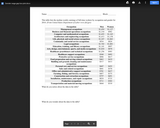
A teacher created resource inspired by Discovering Algebra, using data found at the US Department of Labor
- Subject:
- Algebra
- Mathematics
- Material Type:
- Homework/Assignment
- Author:
- MPS Alegrba Work Group
- Date Added:
- 05/22/2019

A teacher created resource inspired by Discovering Algebra, using data found at the US Department of Labor
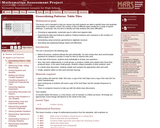
This lesson unit is intended to help teachers assess how well students are able to identify linear and quadratic relationships in a realistic context: the number of tiles of different types that are needed for a range of square tabletops. In particular, this unit aims to identify and help students who have difficulties with: choosing an appropriate, systematic way to collect and organize data; examining the data and looking for patterns; finding invariance and covariance in the numbers of different types of tile; generalizing using numerical, geometrical or algebraic structure; and describing and explaining findings clearly and effectively.

This lesson unit is intended to help you assess how well students working with square numbers are able to: choose an appropriate, systematic way to collect and organize data, examining the data for patterns; describe and explain findings clearly and effectively; generalize using numerical, geometrical, graphical and/or algebraic structure; and explain why certain results are possible/impossible, moving towards a proof.

In this lesson designed to enhance literacy skills, students learn how to read and interpret a distance–time graph.
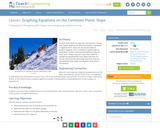
Students learn about an important characteristic of lines: their slopes. Slope can be determined either in graphical or algebraic form. Slope can also be described as positive, negative, zero or undefined. Students get an explanation of when and how these different types of slope occur. Finally, they learn how slope relates to parallel and perpendicular lines. When two lines are parallel, they have the same slope and when they are perpendicular their slopes are negative reciprocals of one another.
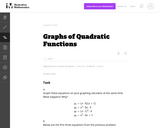
This exploration can be done in class near the beginning of a unit on graphing parabolas. Students need to be familiar with intercepts, and need to know what the vertex is.
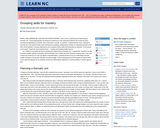
Thematic planning helps relate mathematics to students' lives.

This task is designed to make students think about the meaning of the quantities presented in the context and choose which ones are appropriate for the two different constraints presented. In particular, note that the purpose of the task is to have students generate the constraint equations for each part (though the problem statements avoid using this particular terminology), and not to have students solve said equations.
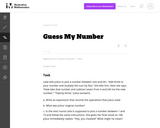
This problem asks the students to represent a sequence of operations using an expression and then to write and solve simple equations. The problem is posed as a game and allows the students to visualize mathematical operations. It would make sense to actually play a similar game in pairs first and then ask the students to record the operations to figure out each other's numbers.
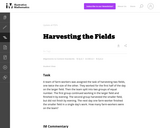
This is a challenging task, suitable for extended work, and reaching into a deep understanding of units. The task requires students to exhibit MP1, Make sense of problems and persevere in solving them. An algebraic solution is possible but complicated; a numerical solution is both simpler and more sophisticated, requiring skilled use of units and quantitative reasoning. Thus the task aligns with either A-CED.1 or N-Q.1, depending on the approach.

HippoCampus is a project of the Monterey Institute for Technology and Education (MITE). The goal of HippoCampus is to provide high-quality, multimedia content on general education subjects to high school and college students free of charge. HippoCampus was designed as part of Open Education Resources (OER), a worldwide effort to improve access to quality education for everyone.

"This course covers the same material as Differential Equations (18.03) with more emphasis on theory. In addition, it treats mathematical aspects of ordinary differential equations such as existence theorems."

This activity has students explore the patterns that emerge when connecting midpoints of triangles. The activity includes a student worksheet, discussion questions, and an interactive fractal tool.
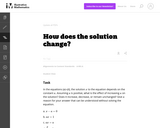
The purpose of this task is to continue a crucial strand of algebraic reasoning begun at the middle school level (e.g, 6.EE.5). By asking students to reason about solutions without explicily solving them, we get at the heart of understanding what an equation is and what it means for a number to be a solution to an equation. The equations are intentionally very simple; the point of the task is not to test technique in solving equations, but to encourage students to reason about them.
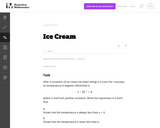
This task illustrates the process of rearranging the terms of an expression to reveal different aspects about the quantity it represents, precisely the language being used in standard A-SSE.B.3.

Students are asked to consider the expression that arises in physics as the combined resistance of two resistors in parallel. However, the context is not explicitly considered here. The task is good general preparation for problems more specifically aligned to either A-SSE.1 or A-SSE.2.
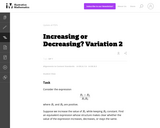
The purpose of this task is to help students see manipulation of expressions as an activity undertaken for a purpose.

Selection of material from the following topics: calculus of variations (the first variation and the second variation); integral equations (Volterra equations; Fredholm equations, the Hilbert-Schmidt theorem); the Hilbert Problem and singular integral equations of Cauchy type; Wiener-Hopf Method and partial differential equations; Wiener-Hopf Method and integral equations; group theory.

Students will learn to solve compound inequalities, absolute value inequalities, and systems of equations, simplify radical expressions, solve quadratic equations and applications and simplify compound fractions, solve rational equations and applications, use function notation to solve problems and use exponential and logarithmic functions.Login: guest_oclPassword: ocl

Containing 4 modules, this textbook covers the intermediate algebra concepts within specific themes such as citizenship, physical world, personal finance, and medical literacy.